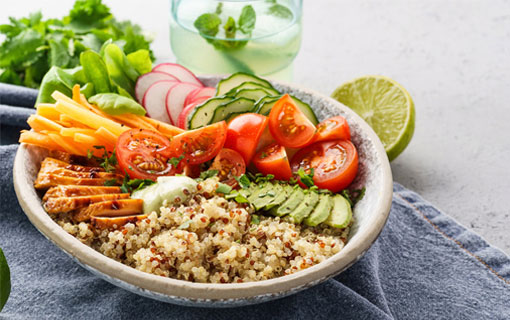Low GI Explained
Backed by more than 40 years of science, a healthy low GI lifestyle is a sustainable way to improve overall good health across all stages of life.
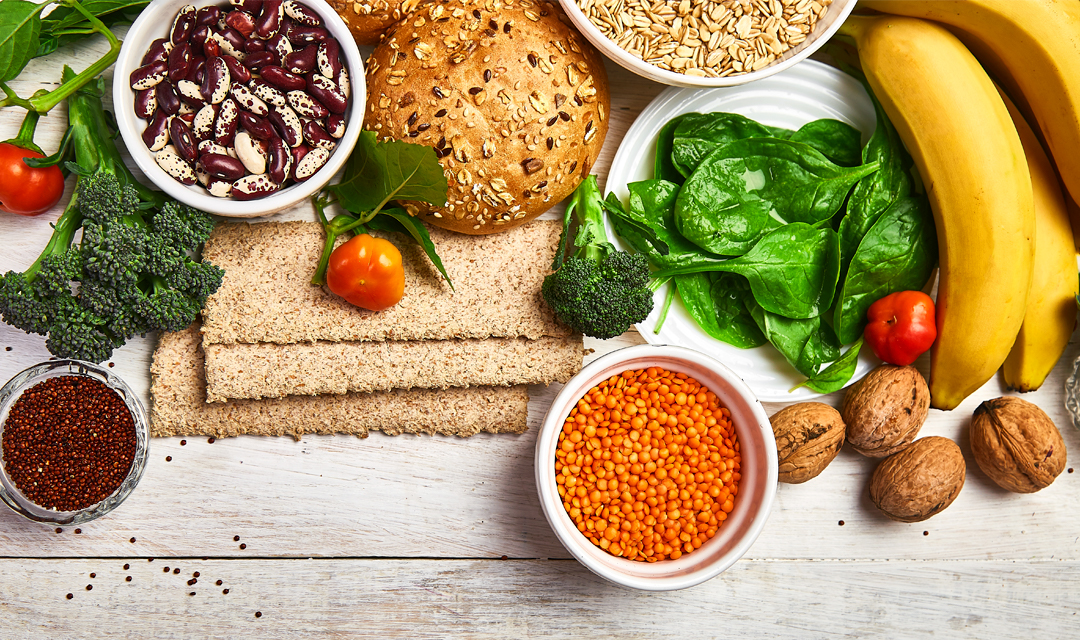
ON THIS PAGE
PRINT, DOWNLOAD, SHARE
What is low GI?
The Glycemic Index (Gi) is a tool that measures how carbohydrates affect blood glucose levels. It then ranks the quality of carbohydrates based on this score.
Carbohydrates are an essential part of our diet since they provide fuel for the brain, most other organs and muscles during exercise. However, not all carbohydrate foods are equal.
High GI carbohydrates cause blood sugar levels to spike and then crash, whereas low GI foods are digested and absorbed more slowly. This slow release of glucose into the bloodstream is proven to be much more beneficial for the body – from improving energy levels to managing weight, diabetes and other health concerns.
Blood glucose levels after eating high and low GI foods
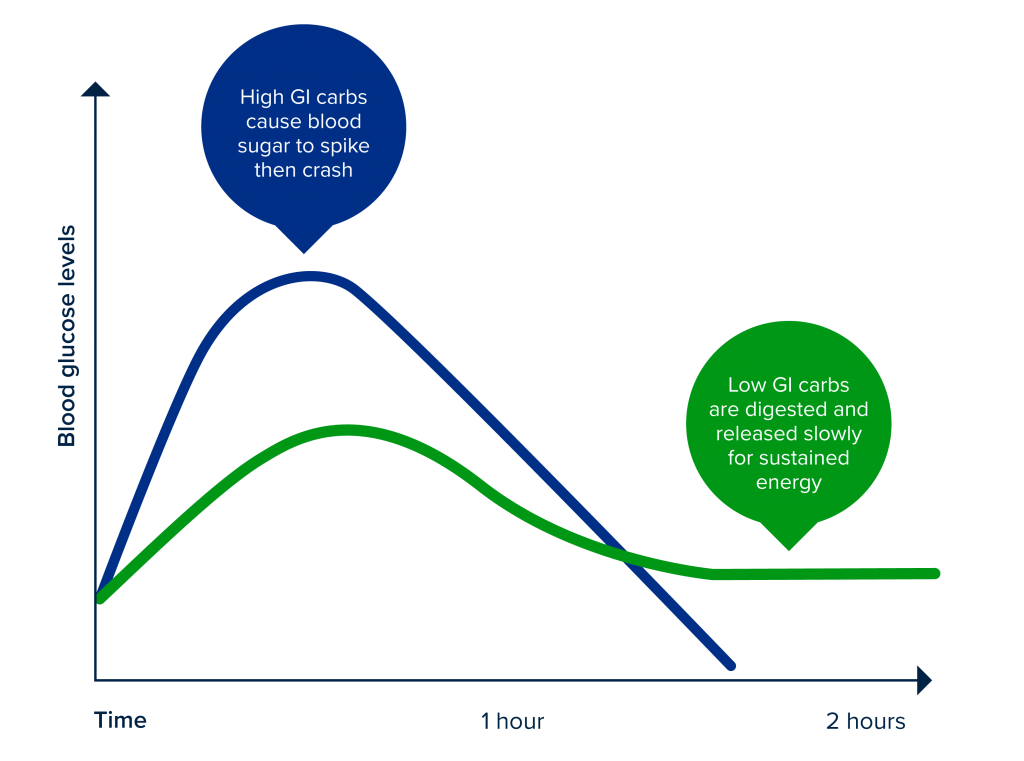
How is GI measured?
Understanding the GI value of a food can help you make healthier food choices and improve your overall health in the long run.
The GI value of foods is calculated in a food laboratory using valid scientific methods. There are three classifications for GI:
Individual food portion:
Low: 55 or less
Mid: 56 – 69
High: 70+
Foods with a high GI score contain carbohydrate that is rapidly digested and produces a sharp rise and fall in the level of blood glucose. In contrast, foods with a low GI score contain slowly digested carbohydrate which produces a more gradual and relatively low rise in the level of blood glucose and insulin levels. GI values of foods must be measured using valid scientific methods. It cannot be guessed by looking at the composition of the food or the nutrition information panel on food packaging.
Following the international standard method, the GI value of a food is determined by feeding 10 or more healthy people a portion of the food containing 50 grams of digestible (available) carbohydrate and then measuring the effect on their blood glucose levels over the next two hours. For each person, the area under their two-hour blood glucose response (glucose AUC) for this food is then measured. On another occasion, the same 10 people consume an equal-carbohydrate portion of the sugar glucose (the reference food) and their two-hour blood glucose response is also measured. A GI value for the test food is then calculated for each person by dividing their glucose AUC for the test food by their glucose AUC for the reference food. The final GI value for the test food is the average GI value for the 10 people.
Foods with a high GI score contain rapidly digested carbohydrate, which produces a large rapid rise and fall in the level of blood glucose. In contrast, foods with a low GI score contain slowly digested carbohydrate, which produces a gradual, relatively low rise in the level of blood glucose.
For more information on GI testing go to www.glycemicindex.com
What is the glycemic response?
After eating a meal, any digestible or available carbohydrates in the meal are absorbed into the blood stream, producing an increase in blood glucose concentration. The rise and fall in glucose can be detected using a blood glucose meter. However, because glucose (glycemic) responses vary markedly from day-to-day for all sorts of reasons, it is almost impossible for you to work out the GI of a food. The GI is the average glycemic response (GR) elicited by a portion of food containing 50 g of available carbohydrate expressed as a percentage of the GR elicited by 50 grams of the reference carbohydrate (e.g., 50 g of glucose). The GI is therefore a ranking of the glycemic potential of the carbohydrate embedded in different foods. It is a characteristic of a food, not a person.
More slowly digestible carbohydrates and minimally processed starchy foods produce a different response compared to rapidly digestible carbohydrates. They produce a slower and more prolonged increase in blood glucose levels, rising to a lower peak.
Other factors that contribute to the glycemic response include the amount of food consumed, how much the food is processed and even how the food has been prepared. For example, pasta that is cooked al dente has a slower glycemic response than pasta that is overcooked.
What about glycemic load?
Your blood glucose levels rise and fall after you eat a meal containing carbohydrate. How high it rises and how long it stays high depends on the quality of the carbohydrate (the GI) as well as the quantity. Glycemic Load (or GL) combines both the quantity and quality of carbohydrate. The formula for calculating the GL of a particular food or meal is:
Glycemic Load = GI (%) x Carbohydrate (grams) content per portion ÷ 100
Where: GI is the GI value using the glucose scale; Carbohydrate per portion is total digestible (or available) carbohydrate, and 100 because the GI is a scale from 0 to 100 that is expressed as a percentage, 1 unit (gram, or g) of glycemic load is equivalent to 1 gram of glucose.
For example, a single apple has a GI of 38 and contains 13 grams of carbohydrates.
GL= 38 x 13/100 = 5g
So an apple provides an equivalent of 5 g of glucose.
A potato has a GI of 85 and contains 14 grams of carbohydrate
GL=85 x14/100 = 12g
So a potato provides an equivalent of 12 g of glucose.
We can therefore predict that the potato will have more than double the glycemic impact of an apple (12 vs 6). Similar to the glycemic index, the glycemic load of a food can be classified as low, medium, or high:
Low: 10g or less
Medium: 11 – 19g
High: 20g or more
The GL of a mixed meal or diet can simply be calculated by summing together the GL values for each ingredient or component. For example, if breakfast was composed of 2 wheat biscuits (GL = 15), ½ a cup of milk (GL = 4) and 2 teaspoons of sugar (GL = 6), its overall GL would be 25 g (15 g + 4 g + 6 g).
For the whole day, a target GL of 100 g has been recommended for people consuming 8,400 kJ (2000 calories).
For people consuming 3 meals per day, a low GL meal would have a GL ≤ 33 g.
For optimal health, you should aim to keep your daily glycemic load under 100.
The glycemic index (Gi) is a ranking system that classifies carb-containing foods by their effect on blood sugar levels. It was created in the early 1980s by Dr David Jenkins.
Should I use GI or GL?
There’s no need for you to calculate the GL of your meals. Although the concept has been useful in scientific research, it’s the GI that’s proven most helpful to people with diabetes and those who are overweight. That’s because a diet with a low GL, unfortunately, can be a ‘mixed bag’ full of healthy low GI carbs in some cases, but too low in carbs and full of the wrong sorts of fats (i.e., saturated) such as those found in many ‘discretionary foods’. The wrong fats won’t be detected by blood glucose, but will cause an increase in your blood triglyceride (TG) level, a powerful predictor of cardiovascular disease.
If you use the GI as it was originally intended – to choose the lower GI option within a food group or category – you will be selecting the one with the lowest GL. Foods are grouped together for a reason – they contain similar nutrients, including amounts of carbohydrate. So, if you choose healthy low GI foods, at least one at each meal, chances are you’re eating a diet that not only keeps blood glucose and TG ‘on an even keel’ but contains balanced amounts of carbohydrates, fats and proteins.
What affects the GI value?
Several factors influence how fast a particular carbohydrate raises blood glucose levels, including how refined or processed the carbohydrate is, the chemical and physical structure of the carbohydrate-food (fruit sugar, fructose, has a different structure to ordinary sugar, sucrose, for example), how the carbohydrate is cooked, and other substances in the food such as fibre or acid – which help to slow the speed of digestion and in turn lower the GI value
How refined the carbohydrate is
This is one of the most important factors that determines the GI of foods. In general, refined or processed carbohydrates have had most of their ‘natural’ fibre removed. The carbohydrate becomes incapable of resisting the digestive enzymes and is therefore rapidly metabolised into glucose.
Chemical structure of the carbohydrate
The body processes glucose very efficiently, (the GI of glucose is 100); it cannot metabolise fructose – or fruit sugar – as easily, which is why fructose has a low GI of 23. Ordinary table sugar, sucrose, is made up of one molecule of glucose linked to one of fructose meaning the GI of table sugar is midway, at 65.
Physical structure of the carbohydrate
The physical structure of the carbohydrate also affects the GI value. Most breads are in the high GI range – not due to the chemical nature of wheat starch, but for two physical reasons:
- The fine particle size of wheat flour gives digestive enzymes greater surface area to attack and metabolise the bread;
- The surface area of bread (particularly white bread), is also increased by its puffed-out, fluffy structure. This results in the GI being significantly raised by these structural attributes.
How carbohydrates are cooked or prepared
Pasta has a GI value of 40-50 which can be reduced by cooking it less. ‘Al dente’ pasta resists the effect of digestive enzymes meaning it has a lower GI, while cooking pasta for longer accelerates starch gelatinisation, to increase the GI.
Presence of fibre
Fibre (either in the carbohydrate itself or in the stomach) protects the starchy carbohydrate from rapid attack by digestive enzymes, and slows digestion in the digestive tract. Both of these consequences ultimately slow down the conversion of the carbohydrate to glucose.
Presence of fat and/or acid
The more fat or acid a carbohydrate food contains, (or the more fat or acid in the stomach during digestion), the slower the carbohydrate food is converted to glucose and absorbed into the bloodstream. The presence of fat and/or acid delays the emptying of the stomach, so adding vinegar, lemon juice or pickles to food will help lower the GI of a meal. Fermenting foods or the sourdough method of baking bread also lowers the GI.
Mixed meals and the effect of extra protein and fat on blood glucose response
Eaten alone, protein and fat have little effect on blood glucose levels, but that’s not to say they don’t affect your blood glucose response when they are combined with a carbohydrate-rich food. Protein will stimulate additional insulin secretion, resulting in lower blood glucose levels. Protein and fat both tend to delay stomach emptying, thereby slowing the rate at which carbohydrate can be digested and absorbed. This means a high fat meal will have a lower glycemic effect than a low fat meal, even if they both contain the same amount and type of carbohydrate.
Download resources
Recommended for you
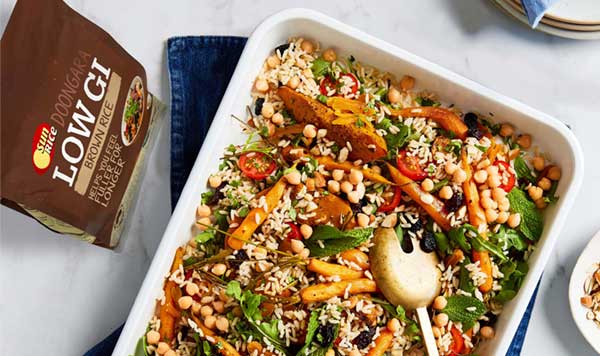
RECIPES
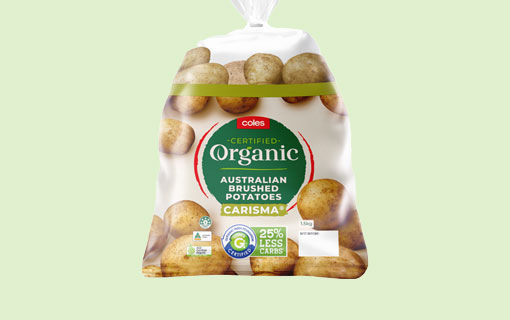
GI CERTIFIED PRODUCTS
DIABETES

LOW GI LIVING


A low GI diet focuses on the quality of carbohydrates you eat. Good carbohydrates (or low GI carbohydrates) are more slowly digested helping keep your blood sugars stable, whereas bad carbohydrates cause your blood glucose levels to peak and crash. Want to know which carbohydrates are best for you? Try our swap it tool!


